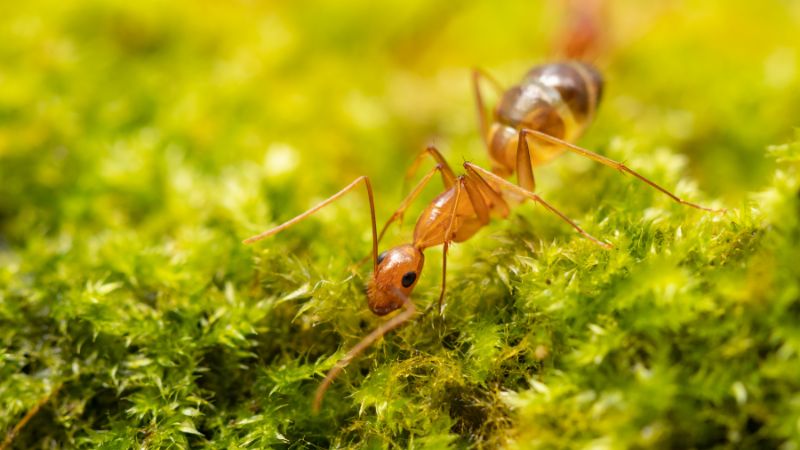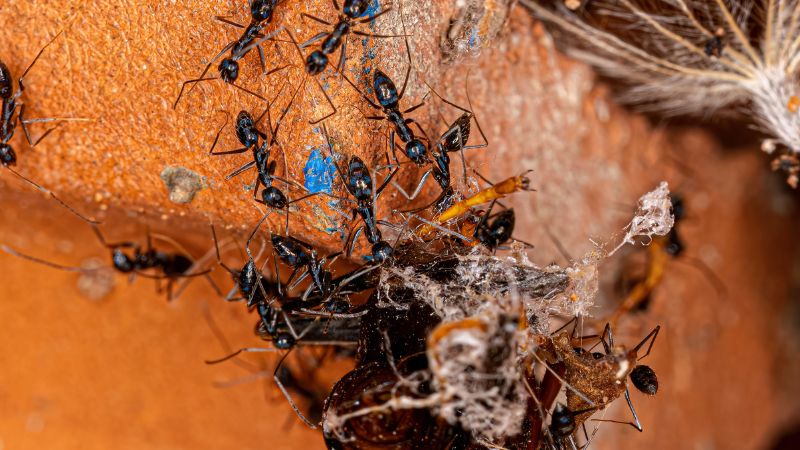If you’ve noticed a large group of ants frantically moving around your home, you may have a problem with crazy ants. These ants are known for their erratic patterns. Because they reproduce quickly, it’s important to act quickly and eliminate them immediately.
So, how to get rid of crazy ants? Start by locating their entry points and nesting sites by using ant killer bait. Afterwards, apply an insecticide spray, dust, or granules at entry points and areas where the ants have frequented. For natural products, you can use diatomaceous earth, vinegar, or borax.
By learning more about crazy ants and their behavior, you can better understand their impact towards local ecosystems and how you can contribute to eliminating them. Read this article for more!
What Are Crazy Ants?

Crazy ants are an invasive species of ants that originated from South America and have spread throughout the Gulf Coast region of the United States since their first detection in Texas in 2002.
These ants are known for their erratic movements, which earned them their common name, and have become a significant pest in the affected areas due to the fact that they occur in large numbers.
Types of Crazy Ants
It’s worth noting that there are several types of crazy ants, each with its unique characteristics and behaviors. The most frequently encountered types of crazy ants include the following:
- Rasberry crazy ant (Nylanderia fulva), also known as the tawny crazy ant, is named after the exterminator Tom Rasberry who first discovered them. They are known for their reddish-brown color and erratic movements.
- Longhorn crazy ant (Paratrechina longicornis), also called the black crazy ant, is named for its long antennae and dark coloration. They are a significant pest in agriculture, and their stings can be painful to humans.
- Yellow crazy ant (Anoplolepis gracilipes) is a pale-yellow colored ant that can form massive colonies and can significantly impact the ecosystem. They are known to displace native ant species and harm other animals.
- Caribbean crazy ant (Nylanderia pubens) is found in Florida and the Caribbean, and they have a reputation for invading homes and buildings. They are reddish brown in color and covered with hairs.
- Robust crazy ant (Nylanderia bourbonica) is considered a minor nuisance pest as they rarely enter buildings and homes. They are more prominent in agriculture and are known to eat scales and aphids.
Rasberry Crazy Ant Queen
One distinctive feature of these ants is their colony organization, which typically includes multiple queens in one colony, unlike other ants with only one queen per colony. A single colony of crazy ants can have as many as 40 queens, contributing to their fast reproduction rate.
What Does a Crazy Ant Look Like?
Crazy ants are relatively small, with an average size of around 3 millimeters for workers. They have distinctively long mandibles, legs, and antenna which make them easily identifiable. Additionally, they are usually reddish brown to black in color, but some species may be yellow.
Do Crazy Ants Bite?
Unlike fire ants, which are native to the same region, crazy ants do not sting. Instead, they only bite. While their bites may cause temporary pain, they generally don’t provoke allergic reactions. The danger of crazy ants is their ability to form large colonies, which can quickly take over yards and homes.
It’s worth noting that crazy ants have developed an antidote to the venom of red fire ants. They do so by covering themselves with formic acid, which is an interesting case of one insect being able to neutralize the venom of another. This is why they displace fire ants in their natural habitats.
What Do Black Crazy Ants Eat?

Black crazy ants have a diet similar to most other ant species, and they feed on small insects, leftover food, seeds, plants, and sweet fruits. Keeping everything clean and free from food scraps is crucial to prevent them from invading your home.
Related: What Do Ants Eat? | Ant Feeding Habits
Are Crazy Ants Dangerous?
One of the biggest challenges with crazy ants is their ability to reproduce rapidly, which make them difficult to eliminate compared to other ant species. However, they are not dangerous regarding their bites or venom, so you needn’t worry about allergic reactions.
Crazy ants are characterized by their erratic movements, distinguishing them from other ants. This frenzied behavior makes them a challenging pest to combat. Additionally, their small size can make it difficult to identify their source.
In the winter, they may invade homes to stay warm. These ants are notorious for infesting electrical equipment such as outlets and air conditioning units and cracks in walls, floors, and furniture. Interestingly, even the NASA Johnson Space Center community has faced issues with crazy ants.
Get Rid of Crazy Ants With Natural Home Remedies
If you prefer using natural home remedies for pest control, there are a few solutions that you can try to get rid of crazy ants.
Diatomaceous Earth
One option is diatomaceous earth, a common and effective powder that can be placed anywhere you find a large group of ants. You can also mix it with sugar to attract more of them. However, the diatomaceous earth must stay dry at all times, as it will lose its effectiveness if it gets in contact with water.
Vinegar Solution
Another option is a mix of vinegar and water. Spray it in places the ants have used to enter your home, as it interferes with their scent. The solution needs to be reapplied regularly, but it is effective nonetheless.
Borax
You can also make a DIY ant bait by adding warm water, ½ tablespoons of borax and ½ cup of sugar. Soak cotton balls in the solution and place them on crazy ant trails where you’ve detected their activity.
When the ants take the bait, they’ll carry it back to the colony and spread it around. Although this option may not be as effective for crazy ants compared to other ant species, it’s worth a try.
Related: 13 Effective Natural Ant Repellents for Your Yard and Home
How to Get Rid of Crazy Ants – Step-by-Step
Inside the House
The first step is to locate their entry points. This can be challenging due to their erratic patterns, so placing ant killer bait is necessary. Once they’ve found the bait, they’ll form a steady line of worker ants that can lead you to their nest.
Once you’ve found their entry points, use a dust or granule insecticide with a residual effect to cover those spots. Using a spray insecticide for the visible ants and foraging inside your home can also be effective. Once you find where the ants are coming from, you have halfway through to eliminate the problem.
Outdoors
For outdoor infestations, finding the crazy ant nests can be difficult due to their tendency to forage far away from their homes. Liquid insecticides designed for destroying ant nests are recommended.
Ant baits in granules can also be effective and more environmentally friendly. Simply spread the ant bait granules near the suspected nest and wait for the ants to bring it inside, which should produce results relatively quickly.
Related: How to Get Rid of Ants | Safe and Effective Methods
Crazy Ant Killer Products
The following are some of the products that you can use to get rid of the crazy ants:
- ATTRACTS & KILLS: TERRO liquid ant baits indoor effectively...
- KILLS THE ANTS YOU DON'T SEE: TERRO ant bait is designed to share...
- FAST-ACTING: Noticeable ant activity reduction within days as...
- READY TO USE: Simply place ant baits indoors with no setup...
- VERSATILE HOME PLACEMENT: TERRO ant traps are ideal for use along...
- Combat Max 2in1 kills the ants you see & the ones you don’t.
- Dual formula kills 11 types of ants, sugar & protein loving ants.
- Deliver insecticide into places where aerosol sprays cannot go.
- Fast acting formula in a convenient and ready to use bait.
- Transparent bait station for easy replacement.
- Raid Max Liquid Ant Bait kills listed ants where they breed...
- Pre-filled liquid ant killer that is both convenient and...
- After ants consume the liquid from the ant bait , they return to...
- For indoor and outdoor use
- Ant bait station that controls listed ants around your home:...
- Attracts & Kills – Kills common household ants including...
- Kills the Ants You See & the Ones You Don't – As worker ants...
- Works Fast – You should see a significant decrease in the...
- Ready to Use – Place the bait stations, push down and twist the...
- For Outdoor Use – Place the bait stations in outdoor areas...
Related: Best Natural Ant Sprays | Kids and Pet-Friendly Sprays
Crazy Ants in Specific Places in the House
Crazy ants are attracted to warm places, and as the temperature drops in the autumn, they may seek shelter inside your home. Here are some specific places in your home where you may find crazy ants and how to get rid of them:
Bathroom
High humidity levels in the bathroom make it an attractive place for crazy ants. They may hide behind the washing machine or beneath the tub if there are cracks in the tiles. Use dust or spray insecticide to destroy their population locally.
Kitchen
Crazy ants are attracted to electrical appliances, which may commonly inhabit your kitchen. They tend to hide behind kitchen counters and in electrical sockets. Use insecticide spray to eliminate any crazy ants in your kitchen instantly. Protect your supplies from the insecticide and thoroughly clean the kitchen after eliminating the ants.
Crazy Ants in Car: What Should You Do?

Crazy ants may invade a car in search of a food source, and once they find it, they leave a trail of pheromones behind them for other ants to follow. Here are some steps to get rid of crazy ants in your car:
- Start by checking your car for any food leftovers and thoroughly clean up the entire car. Even if the food is in your car, crazy ants can easily sense it, so keeping your car as clean as possible is essential.
- Next, change the spot where you park your car for a while. This will break the pheromone trail and deter the ants from coming back.
- Sometimes, you may unknowingly park your car near an anthill or a crazy ant mound. Check the surroundings of your car to see if there is a large number of ants nearby. If you find their colony, you can either change your parking spot or use methods to destroy the nearby crazy ant colony.
Related: Ants in Car: How to Get Rid of Ants in Car
List of Sources
Airhart, M. (2014). Crazy Ants Dominate Fire Ants by Neutralizing Their Venom.
Nickerson, J. C., & Barbara, K. A. (2021). Crazy Ant – Paratrechina longicornis (Latreille).
Texas A&M University. (n.d.). Tawny (Rasberry) Crazy Ant, Nylanderia fulva.
Texas A&M University. (n.d.). Longhorn Crazy Ant, Paratrechina longicornis.
University of Nebraska–Lincoln. (n.d.). Robust crazy ant.
University of Texas at Austin. (n.d.). Crazy Ants.
Williams, R. (2019). Tawny crazy ants’ weird genetics may help them thrive in new environments.
- Bed Bug Surge 2025: How to Detect, Prevent, and Safely Eliminate Infestations in Top U.S. Cities - June 18, 2025
- Asian Needle Ants Invade US Homes: 2025 Guide to Identification, Risks, and Effective Control - June 11, 2025
- New World Screwworm Alert: How US Livestock Owners Can Prevent Outbreaks and Protect Herds [Summer 2025 Update] - June 8, 2025





